Corporate Governance Report
VerifiedAdded on 2019/10/18
|9
|2732
|255
Report
AI Summary
This report examines Ramsay Healthcare Limited's corporate governance structure in the context of the Australian Stock Exchange (ASX) Corporate Governance Council's principles and recommendations. The report details Ramsay's organizational structure, including its board committees (Audit, Risk Management, Remuneration, and Nomination), and assesses its adherence to ASX principles regarding ethical conduct, risk management, stakeholder engagement, and financial reporting. A case study involving a dispute with Medibank over hospital pricing is analyzed, highlighting a situation where Ramsay's practices were questioned. The report concludes by summarizing Ramsay's overall compliance with ASX guidelines and the resolution of the Medibank dispute.

Running Head: CORPORATE GOVERNANCE
CORPORATE GOVERNANCE
CORPORATE GOVERNANCE
Paraphrase This Document
Need a fresh take? Get an instant paraphrase of this document with our AI Paraphraser
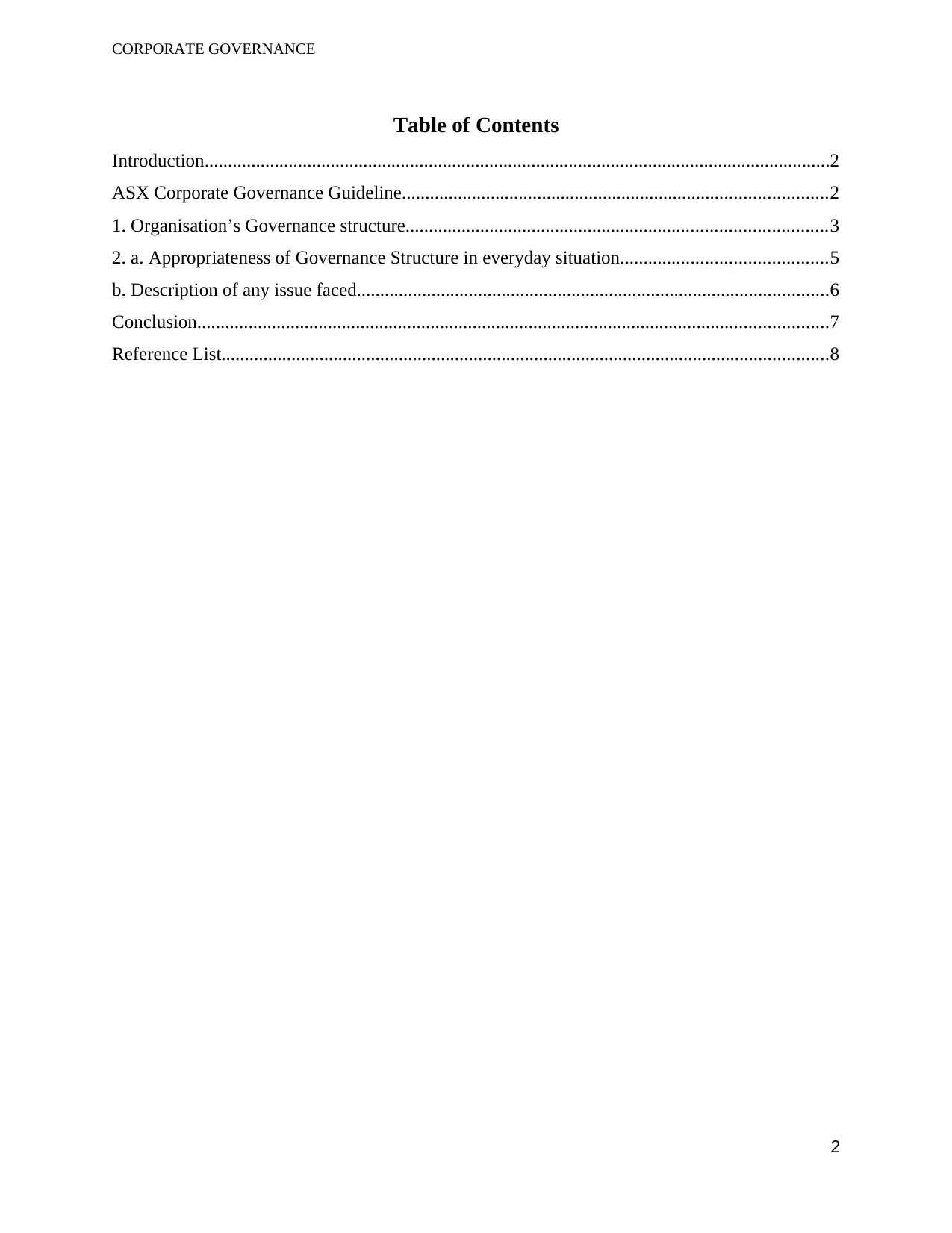
CORPORATE GOVERNANCE
Table of Contents
Introduction......................................................................................................................................2
ASX Corporate Governance Guideline...........................................................................................2
1. Organisation’s Governance structure..........................................................................................3
2. a. Appropriateness of Governance Structure in everyday situation............................................5
b. Description of any issue faced.....................................................................................................6
Conclusion.......................................................................................................................................7
Reference List..................................................................................................................................8
2
Table of Contents
Introduction......................................................................................................................................2
ASX Corporate Governance Guideline...........................................................................................2
1. Organisation’s Governance structure..........................................................................................3
2. a. Appropriateness of Governance Structure in everyday situation............................................5
b. Description of any issue faced.....................................................................................................6
Conclusion.......................................................................................................................................7
Reference List..................................................................................................................................8
2
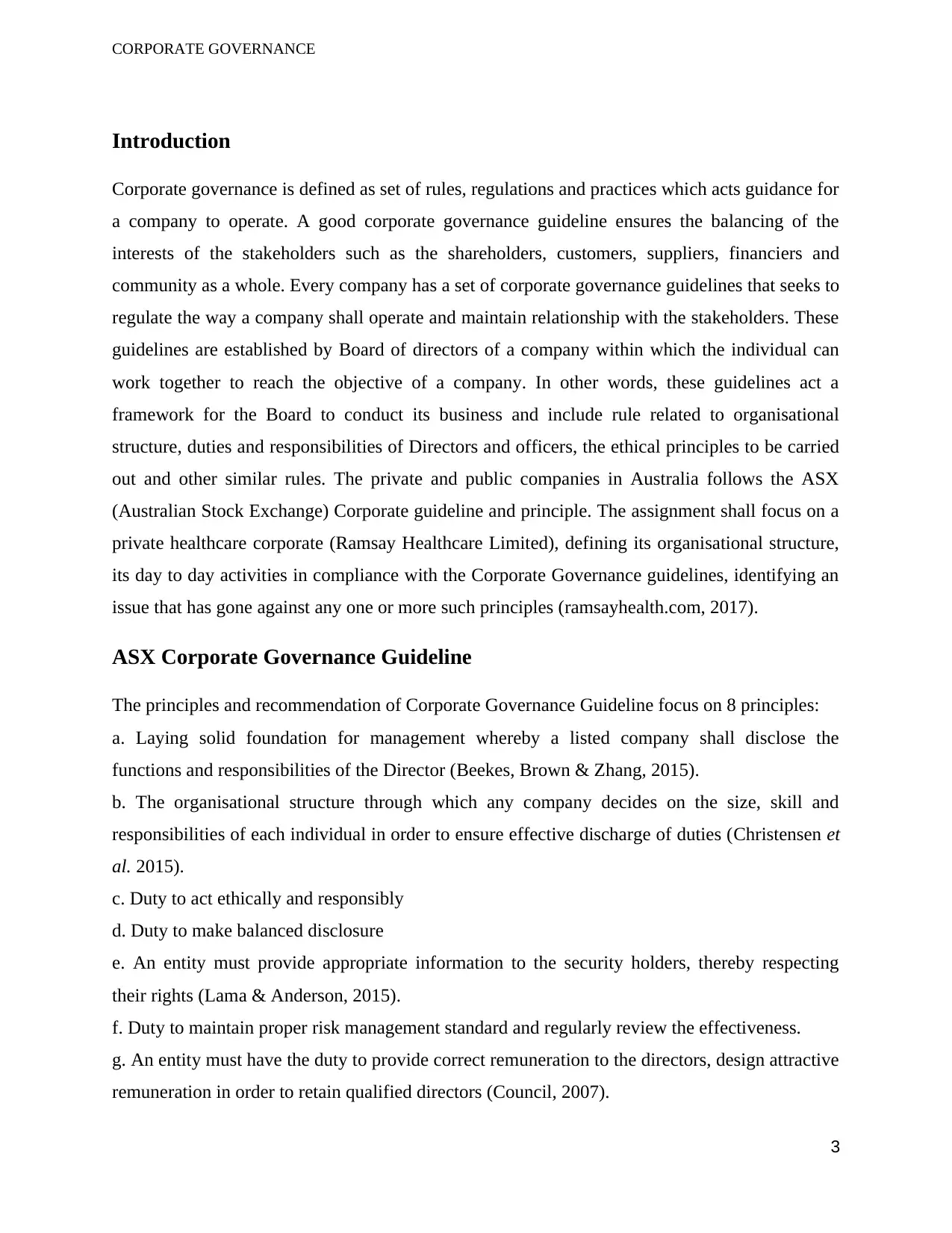
CORPORATE GOVERNANCE
Introduction
Corporate governance is defined as set of rules, regulations and practices which acts guidance for
a company to operate. A good corporate governance guideline ensures the balancing of the
interests of the stakeholders such as the shareholders, customers, suppliers, financiers and
community as a whole. Every company has a set of corporate governance guidelines that seeks to
regulate the way a company shall operate and maintain relationship with the stakeholders. These
guidelines are established by Board of directors of a company within which the individual can
work together to reach the objective of a company. In other words, these guidelines act a
framework for the Board to conduct its business and include rule related to organisational
structure, duties and responsibilities of Directors and officers, the ethical principles to be carried
out and other similar rules. The private and public companies in Australia follows the ASX
(Australian Stock Exchange) Corporate guideline and principle. The assignment shall focus on a
private healthcare corporate (Ramsay Healthcare Limited), defining its organisational structure,
its day to day activities in compliance with the Corporate Governance guidelines, identifying an
issue that has gone against any one or more such principles (ramsayhealth.com, 2017).
ASX Corporate Governance Guideline
The principles and recommendation of Corporate Governance Guideline focus on 8 principles:
a. Laying solid foundation for management whereby a listed company shall disclose the
functions and responsibilities of the Director (Beekes, Brown & Zhang, 2015).
b. The organisational structure through which any company decides on the size, skill and
responsibilities of each individual in order to ensure effective discharge of duties (Christensen et
al. 2015).
c. Duty to act ethically and responsibly
d. Duty to make balanced disclosure
e. An entity must provide appropriate information to the security holders, thereby respecting
their rights (Lama & Anderson, 2015).
f. Duty to maintain proper risk management standard and regularly review the effectiveness.
g. An entity must have the duty to provide correct remuneration to the directors, design attractive
remuneration in order to retain qualified directors (Council, 2007).
3
Introduction
Corporate governance is defined as set of rules, regulations and practices which acts guidance for
a company to operate. A good corporate governance guideline ensures the balancing of the
interests of the stakeholders such as the shareholders, customers, suppliers, financiers and
community as a whole. Every company has a set of corporate governance guidelines that seeks to
regulate the way a company shall operate and maintain relationship with the stakeholders. These
guidelines are established by Board of directors of a company within which the individual can
work together to reach the objective of a company. In other words, these guidelines act a
framework for the Board to conduct its business and include rule related to organisational
structure, duties and responsibilities of Directors and officers, the ethical principles to be carried
out and other similar rules. The private and public companies in Australia follows the ASX
(Australian Stock Exchange) Corporate guideline and principle. The assignment shall focus on a
private healthcare corporate (Ramsay Healthcare Limited), defining its organisational structure,
its day to day activities in compliance with the Corporate Governance guidelines, identifying an
issue that has gone against any one or more such principles (ramsayhealth.com, 2017).
ASX Corporate Governance Guideline
The principles and recommendation of Corporate Governance Guideline focus on 8 principles:
a. Laying solid foundation for management whereby a listed company shall disclose the
functions and responsibilities of the Director (Beekes, Brown & Zhang, 2015).
b. The organisational structure through which any company decides on the size, skill and
responsibilities of each individual in order to ensure effective discharge of duties (Christensen et
al. 2015).
c. Duty to act ethically and responsibly
d. Duty to make balanced disclosure
e. An entity must provide appropriate information to the security holders, thereby respecting
their rights (Lama & Anderson, 2015).
f. Duty to maintain proper risk management standard and regularly review the effectiveness.
g. An entity must have the duty to provide correct remuneration to the directors, design attractive
remuneration in order to retain qualified directors (Council, 2007).
3
⊘ This is a preview!⊘
Do you want full access?
Subscribe today to unlock all pages.

Trusted by 1+ million students worldwide

CORPORATE GOVERNANCE
1. Organisation’s Governance structure
Ramsay Health Care Limited works to deliver high-quality health services, thereby ensuring
long-term growth and sufficient amount of return to the shareholder. The company Board of
Directors understands the implications of Good Governance in fulfilling the corporate objectives,
each discharging their respective responsibilities and executing broader Company role
(ramsayhealth.com, 2017).
The organisation's governance structure can be divided into Governance Framework and Senior
Executive. The Governance Framework includes the functions and responsibilities of the Board
and that are carried out by the Standing Board Committee. Some of the functions include:
● Look after the strategic direction of the company
● Look after the work of the Managing Director and approve the remuneration policies of
senior management.
● Report to the shareholders
● Regular monitoring of the policies to ensure its compliance with the ASX guidelines
● Monitoring of the risk management systems
● Reviewing the annual budget and dividend policy (armidaleprivate.com.au, 2014).
The Governance framework or the organisational structure of Board of Directors includes the
Audit Committee carrying out the key functions of reviewing the procedure of financial
reporting. It also has risk management committee to look after the entire risk management,
control and compliance procedure. The Remuneration Committee reviews the remuneration
policies and incentive. The Nomination Committee looks after the size and composition of the
Board Committee as well as the appointment and reappointment of the members of Board of
Directors (Hodne et al. 2013).
The day-to-day management is looked after by the Managing Director and the responsibility is
delegated by the Board of Directors. The Managing Director includes the departments of
Finance, Corporate and Commercial operations, people and culture, Hospital Operations
Department, marketing, and Global strategy operations (armidaleprivate.com.au, 2014).
The healthcare complies with the principles and guidelines of ASX Corporate Governance
because it believes that a good governance policy ensures effective functioning of an
organisation, thereby giving due consideration to the needs and interest of the stakeholders,
4
1. Organisation’s Governance structure
Ramsay Health Care Limited works to deliver high-quality health services, thereby ensuring
long-term growth and sufficient amount of return to the shareholder. The company Board of
Directors understands the implications of Good Governance in fulfilling the corporate objectives,
each discharging their respective responsibilities and executing broader Company role
(ramsayhealth.com, 2017).
The organisation's governance structure can be divided into Governance Framework and Senior
Executive. The Governance Framework includes the functions and responsibilities of the Board
and that are carried out by the Standing Board Committee. Some of the functions include:
● Look after the strategic direction of the company
● Look after the work of the Managing Director and approve the remuneration policies of
senior management.
● Report to the shareholders
● Regular monitoring of the policies to ensure its compliance with the ASX guidelines
● Monitoring of the risk management systems
● Reviewing the annual budget and dividend policy (armidaleprivate.com.au, 2014).
The Governance framework or the organisational structure of Board of Directors includes the
Audit Committee carrying out the key functions of reviewing the procedure of financial
reporting. It also has risk management committee to look after the entire risk management,
control and compliance procedure. The Remuneration Committee reviews the remuneration
policies and incentive. The Nomination Committee looks after the size and composition of the
Board Committee as well as the appointment and reappointment of the members of Board of
Directors (Hodne et al. 2013).
The day-to-day management is looked after by the Managing Director and the responsibility is
delegated by the Board of Directors. The Managing Director includes the departments of
Finance, Corporate and Commercial operations, people and culture, Hospital Operations
Department, marketing, and Global strategy operations (armidaleprivate.com.au, 2014).
The healthcare complies with the principles and guidelines of ASX Corporate Governance
because it believes that a good governance policy ensures effective functioning of an
organisation, thereby giving due consideration to the needs and interest of the stakeholders,
4
Paraphrase This Document
Need a fresh take? Get an instant paraphrase of this document with our AI Paraphraser
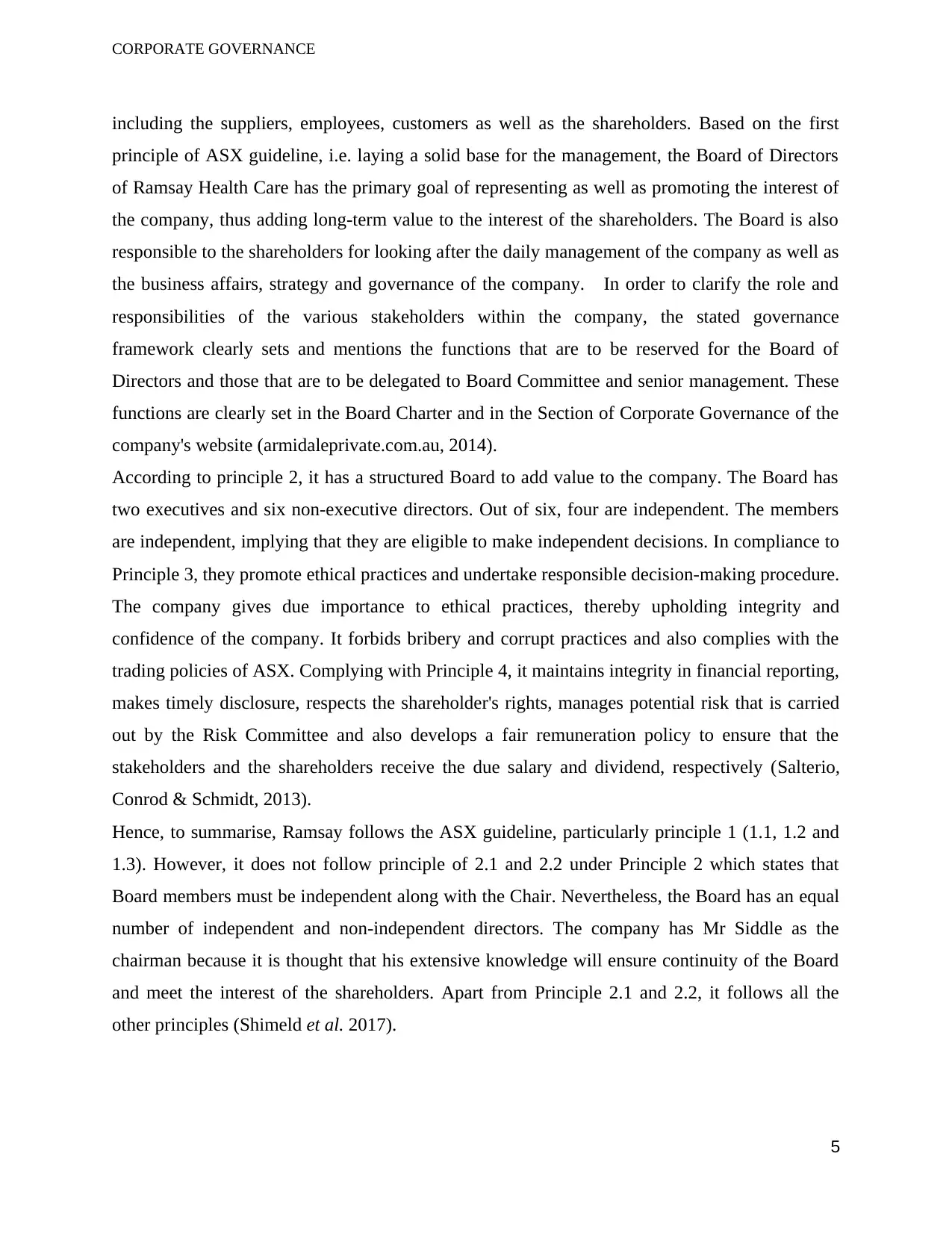
CORPORATE GOVERNANCE
including the suppliers, employees, customers as well as the shareholders. Based on the first
principle of ASX guideline, i.e. laying a solid base for the management, the Board of Directors
of Ramsay Health Care has the primary goal of representing as well as promoting the interest of
the company, thus adding long-term value to the interest of the shareholders. The Board is also
responsible to the shareholders for looking after the daily management of the company as well as
the business affairs, strategy and governance of the company. In order to clarify the role and
responsibilities of the various stakeholders within the company, the stated governance
framework clearly sets and mentions the functions that are to be reserved for the Board of
Directors and those that are to be delegated to Board Committee and senior management. These
functions are clearly set in the Board Charter and in the Section of Corporate Governance of the
company's website (armidaleprivate.com.au, 2014).
According to principle 2, it has a structured Board to add value to the company. The Board has
two executives and six non-executive directors. Out of six, four are independent. The members
are independent, implying that they are eligible to make independent decisions. In compliance to
Principle 3, they promote ethical practices and undertake responsible decision-making procedure.
The company gives due importance to ethical practices, thereby upholding integrity and
confidence of the company. It forbids bribery and corrupt practices and also complies with the
trading policies of ASX. Complying with Principle 4, it maintains integrity in financial reporting,
makes timely disclosure, respects the shareholder's rights, manages potential risk that is carried
out by the Risk Committee and also develops a fair remuneration policy to ensure that the
stakeholders and the shareholders receive the due salary and dividend, respectively (Salterio,
Conrod & Schmidt, 2013).
Hence, to summarise, Ramsay follows the ASX guideline, particularly principle 1 (1.1, 1.2 and
1.3). However, it does not follow principle of 2.1 and 2.2 under Principle 2 which states that
Board members must be independent along with the Chair. Nevertheless, the Board has an equal
number of independent and non-independent directors. The company has Mr Siddle as the
chairman because it is thought that his extensive knowledge will ensure continuity of the Board
and meet the interest of the shareholders. Apart from Principle 2.1 and 2.2, it follows all the
other principles (Shimeld et al. 2017).
5
including the suppliers, employees, customers as well as the shareholders. Based on the first
principle of ASX guideline, i.e. laying a solid base for the management, the Board of Directors
of Ramsay Health Care has the primary goal of representing as well as promoting the interest of
the company, thus adding long-term value to the interest of the shareholders. The Board is also
responsible to the shareholders for looking after the daily management of the company as well as
the business affairs, strategy and governance of the company. In order to clarify the role and
responsibilities of the various stakeholders within the company, the stated governance
framework clearly sets and mentions the functions that are to be reserved for the Board of
Directors and those that are to be delegated to Board Committee and senior management. These
functions are clearly set in the Board Charter and in the Section of Corporate Governance of the
company's website (armidaleprivate.com.au, 2014).
According to principle 2, it has a structured Board to add value to the company. The Board has
two executives and six non-executive directors. Out of six, four are independent. The members
are independent, implying that they are eligible to make independent decisions. In compliance to
Principle 3, they promote ethical practices and undertake responsible decision-making procedure.
The company gives due importance to ethical practices, thereby upholding integrity and
confidence of the company. It forbids bribery and corrupt practices and also complies with the
trading policies of ASX. Complying with Principle 4, it maintains integrity in financial reporting,
makes timely disclosure, respects the shareholder's rights, manages potential risk that is carried
out by the Risk Committee and also develops a fair remuneration policy to ensure that the
stakeholders and the shareholders receive the due salary and dividend, respectively (Salterio,
Conrod & Schmidt, 2013).
Hence, to summarise, Ramsay follows the ASX guideline, particularly principle 1 (1.1, 1.2 and
1.3). However, it does not follow principle of 2.1 and 2.2 under Principle 2 which states that
Board members must be independent along with the Chair. Nevertheless, the Board has an equal
number of independent and non-independent directors. The company has Mr Siddle as the
chairman because it is thought that his extensive knowledge will ensure continuity of the Board
and meet the interest of the shareholders. Apart from Principle 2.1 and 2.2, it follows all the
other principles (Shimeld et al. 2017).
5
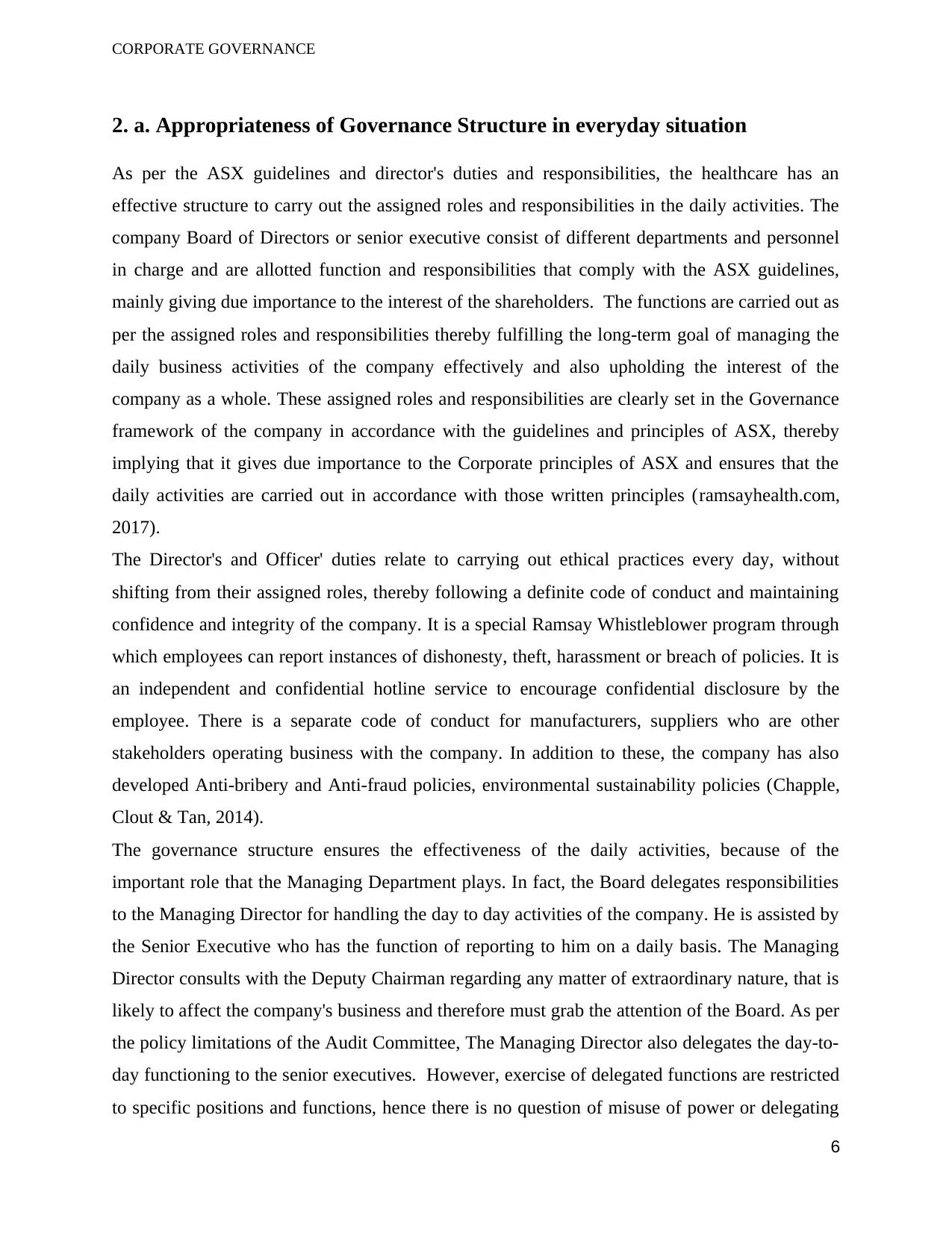
CORPORATE GOVERNANCE
2. a. Appropriateness of Governance Structure in everyday situation
As per the ASX guidelines and director's duties and responsibilities, the healthcare has an
effective structure to carry out the assigned roles and responsibilities in the daily activities. The
company Board of Directors or senior executive consist of different departments and personnel
in charge and are allotted function and responsibilities that comply with the ASX guidelines,
mainly giving due importance to the interest of the shareholders. The functions are carried out as
per the assigned roles and responsibilities thereby fulfilling the long-term goal of managing the
daily business activities of the company effectively and also upholding the interest of the
company as a whole. These assigned roles and responsibilities are clearly set in the Governance
framework of the company in accordance with the guidelines and principles of ASX, thereby
implying that it gives due importance to the Corporate principles of ASX and ensures that the
daily activities are carried out in accordance with those written principles (ramsayhealth.com,
2017).
The Director's and Officer' duties relate to carrying out ethical practices every day, without
shifting from their assigned roles, thereby following a definite code of conduct and maintaining
confidence and integrity of the company. It is a special Ramsay Whistleblower program through
which employees can report instances of dishonesty, theft, harassment or breach of policies. It is
an independent and confidential hotline service to encourage confidential disclosure by the
employee. There is a separate code of conduct for manufacturers, suppliers who are other
stakeholders operating business with the company. In addition to these, the company has also
developed Anti-bribery and Anti-fraud policies, environmental sustainability policies (Chapple,
Clout & Tan, 2014).
The governance structure ensures the effectiveness of the daily activities, because of the
important role that the Managing Department plays. In fact, the Board delegates responsibilities
to the Managing Director for handling the day to day activities of the company. He is assisted by
the Senior Executive who has the function of reporting to him on a daily basis. The Managing
Director consults with the Deputy Chairman regarding any matter of extraordinary nature, that is
likely to affect the company's business and therefore must grab the attention of the Board. As per
the policy limitations of the Audit Committee, The Managing Director also delegates the day-to-
day functioning to the senior executives. However, exercise of delegated functions are restricted
to specific positions and functions, hence there is no question of misuse of power or delegating
6
2. a. Appropriateness of Governance Structure in everyday situation
As per the ASX guidelines and director's duties and responsibilities, the healthcare has an
effective structure to carry out the assigned roles and responsibilities in the daily activities. The
company Board of Directors or senior executive consist of different departments and personnel
in charge and are allotted function and responsibilities that comply with the ASX guidelines,
mainly giving due importance to the interest of the shareholders. The functions are carried out as
per the assigned roles and responsibilities thereby fulfilling the long-term goal of managing the
daily business activities of the company effectively and also upholding the interest of the
company as a whole. These assigned roles and responsibilities are clearly set in the Governance
framework of the company in accordance with the guidelines and principles of ASX, thereby
implying that it gives due importance to the Corporate principles of ASX and ensures that the
daily activities are carried out in accordance with those written principles (ramsayhealth.com,
2017).
The Director's and Officer' duties relate to carrying out ethical practices every day, without
shifting from their assigned roles, thereby following a definite code of conduct and maintaining
confidence and integrity of the company. It is a special Ramsay Whistleblower program through
which employees can report instances of dishonesty, theft, harassment or breach of policies. It is
an independent and confidential hotline service to encourage confidential disclosure by the
employee. There is a separate code of conduct for manufacturers, suppliers who are other
stakeholders operating business with the company. In addition to these, the company has also
developed Anti-bribery and Anti-fraud policies, environmental sustainability policies (Chapple,
Clout & Tan, 2014).
The governance structure ensures the effectiveness of the daily activities, because of the
important role that the Managing Department plays. In fact, the Board delegates responsibilities
to the Managing Director for handling the day to day activities of the company. He is assisted by
the Senior Executive who has the function of reporting to him on a daily basis. The Managing
Director consults with the Deputy Chairman regarding any matter of extraordinary nature, that is
likely to affect the company's business and therefore must grab the attention of the Board. As per
the policy limitations of the Audit Committee, The Managing Director also delegates the day-to-
day functioning to the senior executives. However, exercise of delegated functions are restricted
to specific positions and functions, hence there is no question of misuse of power or delegating
6
⊘ This is a preview!⊘
Do you want full access?
Subscribe today to unlock all pages.

Trusted by 1+ million students worldwide
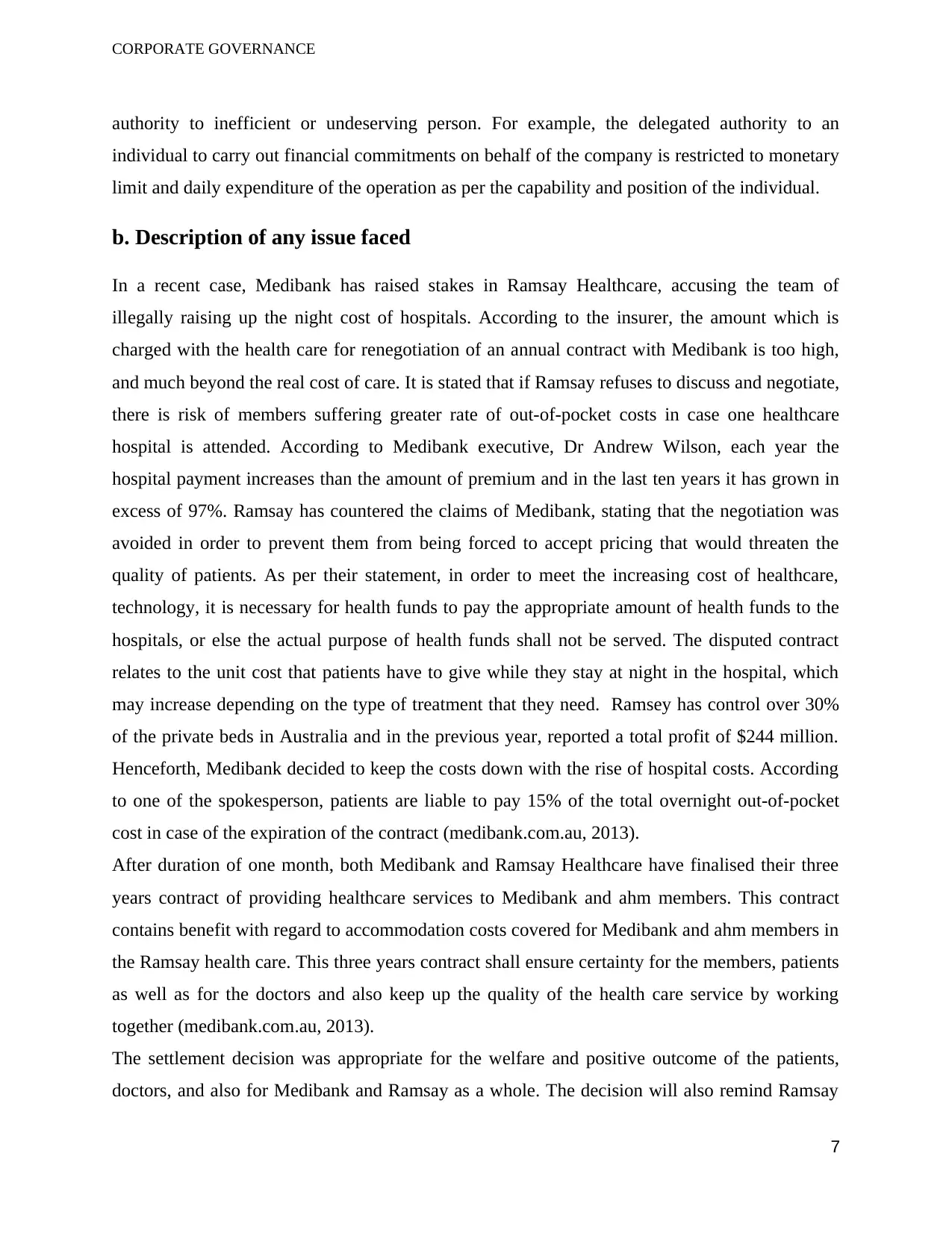
CORPORATE GOVERNANCE
authority to inefficient or undeserving person. For example, the delegated authority to an
individual to carry out financial commitments on behalf of the company is restricted to monetary
limit and daily expenditure of the operation as per the capability and position of the individual.
b. Description of any issue faced
In a recent case, Medibank has raised stakes in Ramsay Healthcare, accusing the team of
illegally raising up the night cost of hospitals. According to the insurer, the amount which is
charged with the health care for renegotiation of an annual contract with Medibank is too high,
and much beyond the real cost of care. It is stated that if Ramsay refuses to discuss and negotiate,
there is risk of members suffering greater rate of out-of-pocket costs in case one healthcare
hospital is attended. According to Medibank executive, Dr Andrew Wilson, each year the
hospital payment increases than the amount of premium and in the last ten years it has grown in
excess of 97%. Ramsay has countered the claims of Medibank, stating that the negotiation was
avoided in order to prevent them from being forced to accept pricing that would threaten the
quality of patients. As per their statement, in order to meet the increasing cost of healthcare,
technology, it is necessary for health funds to pay the appropriate amount of health funds to the
hospitals, or else the actual purpose of health funds shall not be served. The disputed contract
relates to the unit cost that patients have to give while they stay at night in the hospital, which
may increase depending on the type of treatment that they need. Ramsey has control over 30%
of the private beds in Australia and in the previous year, reported a total profit of $244 million.
Henceforth, Medibank decided to keep the costs down with the rise of hospital costs. According
to one of the spokesperson, patients are liable to pay 15% of the total overnight out-of-pocket
cost in case of the expiration of the contract (medibank.com.au, 2013).
After duration of one month, both Medibank and Ramsay Healthcare have finalised their three
years contract of providing healthcare services to Medibank and ahm members. This contract
contains benefit with regard to accommodation costs covered for Medibank and ahm members in
the Ramsay health care. This three years contract shall ensure certainty for the members, patients
as well as for the doctors and also keep up the quality of the health care service by working
together (medibank.com.au, 2013).
The settlement decision was appropriate for the welfare and positive outcome of the patients,
doctors, and also for Medibank and Ramsay as a whole. The decision will also remind Ramsay
7
authority to inefficient or undeserving person. For example, the delegated authority to an
individual to carry out financial commitments on behalf of the company is restricted to monetary
limit and daily expenditure of the operation as per the capability and position of the individual.
b. Description of any issue faced
In a recent case, Medibank has raised stakes in Ramsay Healthcare, accusing the team of
illegally raising up the night cost of hospitals. According to the insurer, the amount which is
charged with the health care for renegotiation of an annual contract with Medibank is too high,
and much beyond the real cost of care. It is stated that if Ramsay refuses to discuss and negotiate,
there is risk of members suffering greater rate of out-of-pocket costs in case one healthcare
hospital is attended. According to Medibank executive, Dr Andrew Wilson, each year the
hospital payment increases than the amount of premium and in the last ten years it has grown in
excess of 97%. Ramsay has countered the claims of Medibank, stating that the negotiation was
avoided in order to prevent them from being forced to accept pricing that would threaten the
quality of patients. As per their statement, in order to meet the increasing cost of healthcare,
technology, it is necessary for health funds to pay the appropriate amount of health funds to the
hospitals, or else the actual purpose of health funds shall not be served. The disputed contract
relates to the unit cost that patients have to give while they stay at night in the hospital, which
may increase depending on the type of treatment that they need. Ramsey has control over 30%
of the private beds in Australia and in the previous year, reported a total profit of $244 million.
Henceforth, Medibank decided to keep the costs down with the rise of hospital costs. According
to one of the spokesperson, patients are liable to pay 15% of the total overnight out-of-pocket
cost in case of the expiration of the contract (medibank.com.au, 2013).
After duration of one month, both Medibank and Ramsay Healthcare have finalised their three
years contract of providing healthcare services to Medibank and ahm members. This contract
contains benefit with regard to accommodation costs covered for Medibank and ahm members in
the Ramsay health care. This three years contract shall ensure certainty for the members, patients
as well as for the doctors and also keep up the quality of the health care service by working
together (medibank.com.au, 2013).
The settlement decision was appropriate for the welfare and positive outcome of the patients,
doctors, and also for Medibank and Ramsay as a whole. The decision will also remind Ramsay
7
Paraphrase This Document
Need a fresh take? Get an instant paraphrase of this document with our AI Paraphraser

CORPORATE GOVERNANCE
of its commitment regarding the improvement of the quality of the health care service provided
to the patients and shall continue for both aim as well as the Medibank members.
Conclusion
The ASX guideline has served as the backbone for operating company business and framing
rules and regulation with regard to the functions of Officers and Directors. The assignment has
focused on the corporate governance structure of Ramsay Health care and it has been seen that
starting from duties and responsibilities to having a proper organisational structure, it has
complied with the guidelines of ASX, except the two primary principles of 2.1 and 2.1. It has
focused on providing quality health care service and upholding the interest of the shareholders
and stakeholders. It also has definite policies with regard to ethical code of conduct in order to
prevent any workplace corruption and bribery that is likely to affect the interest of all.
8
of its commitment regarding the improvement of the quality of the health care service provided
to the patients and shall continue for both aim as well as the Medibank members.
Conclusion
The ASX guideline has served as the backbone for operating company business and framing
rules and regulation with regard to the functions of Officers and Directors. The assignment has
focused on the corporate governance structure of Ramsay Health care and it has been seen that
starting from duties and responsibilities to having a proper organisational structure, it has
complied with the guidelines of ASX, except the two primary principles of 2.1 and 2.1. It has
focused on providing quality health care service and upholding the interest of the shareholders
and stakeholders. It also has definite policies with regard to ethical code of conduct in order to
prevent any workplace corruption and bribery that is likely to affect the interest of all.
8

CORPORATE GOVERNANCE
Reference List
armidaleprivate.com.au (2014), “Corporate Governance Statement, “Retrieved on 18th Sept,
2017, from: http://www.armidaleprivate.com.au/~/media/Documents/RHC/Performance
%20Report/Corporate-Governance-Statement-2014.ashx?la=en
Beekes, W., Brown, P., & Zhang, Q. (2015). Corporate governance and the informativeness of
disclosures in Australia: a re‐examination. Accounting & Finance, 55(4), 931-963.
Chapple, L., Clout, V. J., & Tan, D. (2014). Corporate governance and securities class
actions. Australian Journal of Management, 39(4), 525-547.
Christensen, J., Kent, P., Routledge, J., & Stewart, J. (2015). Do corporate governance
recommendations improve the performance and accountability of small listed
companies?. Accounting & Finance, 55(1), 133-164.
Council, A. C. G. (2007). Corporate governance principles and recommendations.
Hodne, N., Murphy, S., Ottenbacher, M., & Ruggles, T. (2013). Australia and the United States:
A Comparison and Contrast of Corporate Governance Practices.
Lama, T., & Anderson, W. W. (2015). Company characteristics and compliance with ASX
corporate governance principles. Pacific Accounting Review, 27(3), 373-392.
medibank.com.au (2013), “Medibank and Ramsay better now,” Retrieved on 18th September,
2017, from: http://www.medibank.com.au/about-us/media-centre-details.aspx?news=505
ramsayhealth.com (2017), retrieved on 18th Sept, 2017, from: http://www.ramsayhealth.com/
Salterio, S. E., Conrod, J. E., & Schmidt, R. N. (2013). Canadian evidence of adherence to
“comply or explain” corporate governance codes: An international
comparison. Accounting Perspectives, 12(1), 23-51.
Shimeld, S., Shimeld, S., Williams, B., Williams, B., Shimeld, J., & Shimeld, J. (2017).
Diversity ASX corporate governance recommendations: a step towards
change?. Sustainability Accounting, Management and Policy Journal, 8(3), 335-357.
9
Reference List
armidaleprivate.com.au (2014), “Corporate Governance Statement, “Retrieved on 18th Sept,
2017, from: http://www.armidaleprivate.com.au/~/media/Documents/RHC/Performance
%20Report/Corporate-Governance-Statement-2014.ashx?la=en
Beekes, W., Brown, P., & Zhang, Q. (2015). Corporate governance and the informativeness of
disclosures in Australia: a re‐examination. Accounting & Finance, 55(4), 931-963.
Chapple, L., Clout, V. J., & Tan, D. (2014). Corporate governance and securities class
actions. Australian Journal of Management, 39(4), 525-547.
Christensen, J., Kent, P., Routledge, J., & Stewart, J. (2015). Do corporate governance
recommendations improve the performance and accountability of small listed
companies?. Accounting & Finance, 55(1), 133-164.
Council, A. C. G. (2007). Corporate governance principles and recommendations.
Hodne, N., Murphy, S., Ottenbacher, M., & Ruggles, T. (2013). Australia and the United States:
A Comparison and Contrast of Corporate Governance Practices.
Lama, T., & Anderson, W. W. (2015). Company characteristics and compliance with ASX
corporate governance principles. Pacific Accounting Review, 27(3), 373-392.
medibank.com.au (2013), “Medibank and Ramsay better now,” Retrieved on 18th September,
2017, from: http://www.medibank.com.au/about-us/media-centre-details.aspx?news=505
ramsayhealth.com (2017), retrieved on 18th Sept, 2017, from: http://www.ramsayhealth.com/
Salterio, S. E., Conrod, J. E., & Schmidt, R. N. (2013). Canadian evidence of adherence to
“comply or explain” corporate governance codes: An international
comparison. Accounting Perspectives, 12(1), 23-51.
Shimeld, S., Shimeld, S., Williams, B., Williams, B., Shimeld, J., & Shimeld, J. (2017).
Diversity ASX corporate governance recommendations: a step towards
change?. Sustainability Accounting, Management and Policy Journal, 8(3), 335-357.
9
⊘ This is a preview!⊘
Do you want full access?
Subscribe today to unlock all pages.

Trusted by 1+ million students worldwide
1 out of 9
Related Documents
Your All-in-One AI-Powered Toolkit for Academic Success.
+13062052269
info@desklib.com
Available 24*7 on WhatsApp / Email
![[object Object]](/_next/static/media/star-bottom.7253800d.svg)
Unlock your academic potential
Copyright © 2020–2025 A2Z Services. All Rights Reserved. Developed and managed by ZUCOL.





